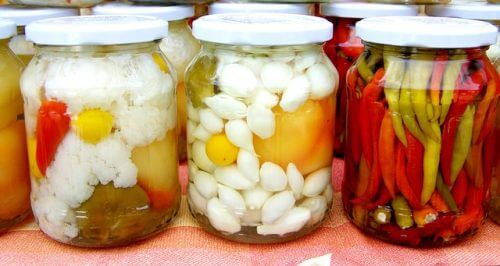Canning food is a relatively simple process that just takes time and the right equipment. There are two different methods for canning food. One is a water-bath canning method and the other is a pressure canning cooker. Both require using the glass ball jars with seals and lids. Most vegetables and fruit can be canned use the water bath method of canning but other foods, such as meats, soups, and stews, are done best using a pressure cooker.
 Some will argue that pressure canning eliminates any chance of unwanted bacteria from improper heating. Speaking from my experience, I have personally never had any issues with using the water-bath method of canning. Follow the chart for boiling times and just make sure the jars seal themselves when cooling. Here is a great free guide distributed by USDA that is very informative.
Some will argue that pressure canning eliminates any chance of unwanted bacteria from improper heating. Speaking from my experience, I have personally never had any issues with using the water-bath method of canning. Follow the chart for boiling times and just make sure the jars seal themselves when cooling. Here is a great free guide distributed by USDA that is very informative.
Water-Bath Method For Canning Food
With the water-bath method of canning, all that is needed is a large enough pot and lid with a rack to lift out the hot jars. The rack is necessary to distribute an even flow of heat throughout the canning process so that the jars seal properly. It also makes it easier lifting the jars in and out of the canner. I always wash and boil my jars, lids, and rings until they are sterilized and hot. Then remove them from the pot and fill them with blanched vegetables, ensuring that they are covered in the hot water they were blanched in.
I then put the sterilized lids and ring on the jars, then return them to the boiling pot for the required amount of time. Upon removing the jars from the water-bath pot, the jars will cool, and you will hear the popping of the lids as they create an airtight seal. Rings can be removed and used on other jars for canning. The great thing about canning is that your jars and rings can be used over and over again every year. Lids are usually the first thing to be replaced as they do eventually wear out and will not seal properly.
Pressure Cooker Method For Canning Food
Using a pressure cooker is a little more complicated, but much less time consuming than using the water-bath canning. It is also less likely that any food would be contaminated by improper sterilization or sealing of the canning jars. Pressure canning cookers are more expensive but offer the convenience of saving time and ensuring food safety. Depending on the amount you wish to can, different sizes are available. The larger pressure canners can hold up to twenty-one-quart jars.
They are either weight gauged or dial gauged, depending on the pressure canner. I personally prefer the weight gauged canners because they require less maintenance and usually outlive most of the dial gauged. They usually come with precise instructions on operating and maintaining safety procedures during use. Most also have built in safety features that prevent any malfunction that could be dangerous. An occasional seal replacement may be necessary when using any pressure canner. It is as simple as ordering it from the manufacturer. See our review here for a canning pressure cooker that is very popular and made in the USA.
Some Safety Canning Tips
- Always follow the instructions that come with your canner
- Use canning recipes and follow exact time requirements and pressure settings for proper processing
- Make sure food is cleaned properly and blanched
- Jars, lids & rings need to be washed and sterilized before adding food
- Make sure you are using a jar rack to lift and lower the jars into the canner
- Be sure seals are not damaged prior to canning and that they concave and seal properly
Home canning is a very simple process that just takes a couple of times to get the hang of. It has been a source of putting extra food on the table, especially in difficult economic times. For many of you, this may be the learning of a new skill, but for us old-timers it’s just another way to conserve and save ourselves some money. Prepping is big now with the uncertainty of our economic times and canning food provides an abundance of ready-to-eat food that anybody can store. Don’t be caught unaware when you can do something to ward off the inflation of food costs and be ready for any unexpected events. Food preservation begins with each and every one of us.

Leave a Reply